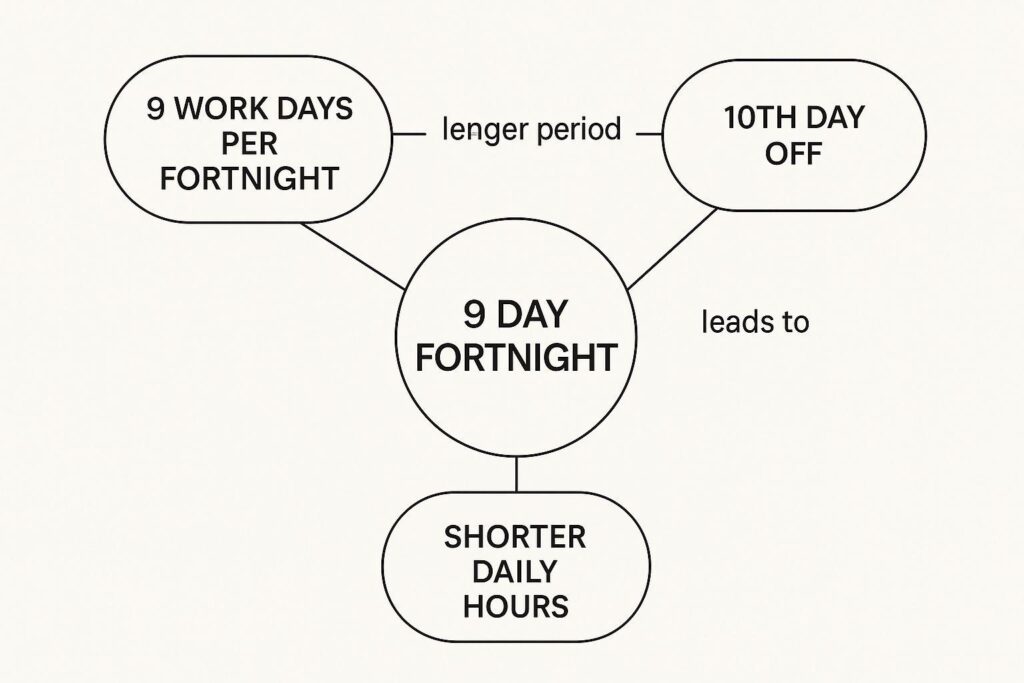The 9 Day Fortnight Work-Life Revolution
A 9-day fortnight is a compressed work schedule where you work your full contracted hours over nine days instead of the usual ten. The payoff? You get a three-day weekend every other week. It’s a simple but effective way to shift the work-life balance in your favour by working a bit longer on your scheduled days.
What a 9-Day Fortnight Actually Means
Think about your standard two-week work period. That’s usually ten days on, four days off. Now, imagine taking the total hours you work in those ten days and spreading them across just nine. That’s the whole idea behind the 9-day fortnight.
It’s not about cutting your hours or your pay. It’s about working smarter with your time to get a full day back for yourself every two weeks. This simple change can completely alter your rhythm, giving you a predictable long weekend to look forward to. It’s a meaningful break you can use to recharge, run errands, or dive into a hobby without eating into your annual leave.
How the Hours are Structured
So, how does it work in practice? To make up for that tenth day off, a small amount of extra time is added to the other nine days. This often means working a slightly longer day than the typical 8-hour shift.
For example, a common setup involves working a full five-day week, followed by a four-day week where you get Friday off. To make this happen, you might add anywhere from 30 minutes to an hour to your other nine workdays. This could look like a 9-hour-and-20-minute day, including your usual breaks. You can dig deeper into how this kind of compressed schedule can reduce employee stress and improve wellbeing.
The image below gives a clear visual of how the schedule is rebalanced.

As you can see, it’s a direct trade-off: work nine slightly longer days, and you earn an extra day off.
The core idea is simple: the 9-day fortnight is all about consolidating your time. You’re not working less; you’re just rearranging your hours to create bigger, more useful blocks of personal time.
To really see the difference, let’s compare a standard two-week schedule with a 9-day fortnight model for a 40-hour work week (80 hours total).
Standard Week vs 9-Day Fortnight Schedule Example
| Day | Standard Schedule (Hours) | 9-Day Fortnight Schedule (Hours) |
|---|---|---|
| Week 1 | ||
| Monday | 8 | 8.9 |
| Tuesday | 8 | 8.9 |
| Wednesday | 8 | 8.9 |
| Thursday | 8 | 8.9 |
| Friday | 8 | 8.9 |
| Saturday | 0 | 0 |
| Sunday | 0 | 0 |
| Week 2 | ||
| Monday | 8 | 8.9 |
| Tuesday | 8 | 8.9 |
| Wednesday | 8 | 8.9 |
| Thursday | 8 | 8.9 |
| Friday | 8 | 0 (Day Off) |
| Saturday | 0 | 0 |
| Sunday | 0 | 0 |
| Total Hours | 80 | 80 |
Note: Hours are rounded for simplicity. A typical 80-hour fortnight would require working approximately 8 hours and 54 minutes per day.
As the table shows, the total hours are identical, but the structure creates a regular three-day weekend. This model is a fantastic middle ground between a traditional five-day week and a full four-day week. It aims for a few key results:
- Better Work-Life Balance: That recurring long weekend is a game-changer for personal wellbeing.
- Maintained Productivity: Since total hours don’t change, businesses can maintain their expected output.
- Greater Employee Autonomy: It’s a sign of trust, giving people more control over how they manage their time and energy.
Ultimately, the goal is to give employees more ownership of their schedules. It’s a practical, achievable adjustment that can lead to a healthier, more engaged, and more loyal team—a win for everyone involved.
Why Businesses Are Adopting This Schedule
In a fierce job market, a competitive salary just doesn’t cut it anymore. Companies are looking for ways to stand out, and the 9-day fortnight is quickly becoming a powerful way to do just that. It’s a clear signal to everyone—from potential hires to seasoned staff—that a company is serious about employee well-being and building a modern, trusting work culture.
This isn’t just about offering another perk; it’s a strategic move that delivers real business results.

Adopting this schedule sends a powerful message. It tells your team you trust them to manage their time and that you value their lives outside of work. This kind of mutual respect is the foundation of a rock-solid company culture and fosters a deep sense of loyalty.
Boosting Productivity And Focus
You might think cramming a full work week into fewer, longer days would lead to burnout. But surprisingly, many companies find the exact opposite happens. With a three-day weekend always just around the corner, employees are often more motivated and dialled in. They become masters of prioritisation, knowing they have a clear finish line before a much-needed break.
This sharp focus translates directly into better productivity. Instead of the usual end-of-week slump, the promise of a day off keeps energy levels high. This cycle of intense work followed by proper rest can spark more creativity and lead to smarter problem-solving.
A rested and recharged employee is a more creative and dedicated one. The 9 day fortnight isn’t about working less; it’s about creating a rhythm that allows people to bring their best selves to work consistently.
Tangible Operational Benefits
The perks of a 9-day fortnight go beyond just morale and productivity—they can actually show up on your bottom line. Closing the office or running on a skeleton crew for one extra day every two weeks can create some noticeable savings.
Think about the small things that add up:
- Utilities: That’s 26 extra days a year where you’re not paying to power lights, air conditioning, and all the office equipment. It makes a difference.
- Office Consumables: Fewer days in the office means burning through less paper, coffee, snacks, and other supplies.
- Overheads: For businesses that can shut their doors completely, the reduction in running costs can be quite significant over a year.
This forward-thinking approach is a big reason why many companies making this switch are recognised among the best companies to work for. It’s a clear demonstration of a strategy that benefits both the people and the business.
Ultimately, the 9-day fortnight is more than just a scheduling change; it’s a smart business decision. It strengthens your employer brand, ramps up productivity, and can even help trim the budget. It’s that rare win-win: employees get back precious time, and the business gets a more engaged, efficient, and loyal team.
The True Impact of a Recurring Three-Day Weekend
A recurring three-day weekend isn’t just an extra day off—it completely redesigns the rhythm of an employee’s life. The impact of having a predictable, long weekend every other week goes much deeper than just more leisure time. It creates a powerful shift in well-being, autonomy, and how people feel about their lives overall.
Think about it. This schedule carves out the breathing room that modern life so often squeezes out of our calendars.
Imagine finally having a dedicated day for all those essential life tasks that are a nightmare to fit in. Doctor’s appointments, a trip to the bank, or attending your child’s school event no longer mean burning through annual leave or a frantic post-work dash. This predictability melts away the constant, low-level stress of life admin.
Recharging and Re-Engaging
The real magic of the 9-day fortnight is the chance for genuine rest. A standard two-day weekend often feels too short to truly disconnect. By the time you’ve finally wound down on Saturday, Sunday is already filled with the mental prep for the week ahead.
A three-day weekend breaks this cycle. It gives your team the space to properly switch off, dive into hobbies, take short trips, or just enjoy quality time with family and friends. This mental reset is absolutely crucial for preventing burnout and protecting long-term mental health.
When an employee comes back to work after a proper break, they aren’t just rested—they are re-engaged. Their focus is sharper, creativity is flowing again, and their problem-solving skills are heightened because they’ve had a real chance to recharge.
Fostering Trust and Autonomy
Bringing in a 9-day fortnight sends a powerful message of trust. It shows your people that you value their well-being and trust them to manage their work effectively, even with a non-traditional schedule. That sense of autonomy is a huge driver of job satisfaction and loyalty.
This model naturally shifts the focus from “hours clocked” to “work accomplished,” empowering employees to take real ownership of their productivity. This approach is perfectly in step with what today’s workforce expects and is a key part of many forward-thinking hiring plans. As you look to attract the best people, it’s worth exploring the latest hiring trends to reinvent your recruiting strategy that champion flexibility and trust.
This increased control and respect can create a significant boost in morale. Employees feel seen as individuals, not just cogs in a machine. That feeling strengthens their commitment to the company’s goals and cultivates a more positive, collaborative work environment for everyone involved.
Navigating the Common Implementation Challenges
Switching to a 9-day fortnight is an exciting thought, but it’s not as simple as flipping a switch. You can’t just decide on Monday that everyone gets every other Friday off. To get it right, you have to think ahead, anticipate the hurdles, and have a solid plan in place. With the right strategy, these challenges become manageable speed bumps, not total deal-breakers.
Adopting this new way of working demands some careful planning, especially when it comes to keeping the business running smoothly and your people happy. The biggest worries usually circle back to two things: keeping service levels high and making sure the longer days don’t just lead to exhaustion.

Maintaining Seamless Customer Service
A major question for any business is client availability. How do you give everyone an extra day off without leaving your customers hanging? The fear of a client calling on a Friday only to find the office empty is very real, but thankfully, it’s also easy to solve.
The most popular and effective fix is to stagger the schedules. It’s a simple idea: split your workforce into two or more groups.
- Team A gets the first Friday of the fortnight off.
- Team B gets the second Friday of the fortnight off.
This rotation ensures there’s always staff on deck. Customers always have someone to talk to, and internal work can move forward without grinding to a halt. Critical tasks are always covered, and the business looks just as professional as ever. This thinking also applies to keeping your talent pipeline full; for instance, understanding how recruitment process outsourcing can help means your hiring can continue seamlessly, even with staggered schedules.
Preventing Burnout From Longer Days
The trade-off for that extra day off is, of course, working slightly longer hours on the other nine days. While most employees are happy to make that swap, there’s a real risk of fatigue if it isn’t managed well. Tacking an extra hour onto the day can be draining, and if you’re not careful, it can undermine the very work-life balance you’re trying to build.
The whole point of a 9-day fortnight is to improve well-being, not make it worse. Success comes down to creating a sustainable rhythm, where longer days are productive but not punishing.
To get ahead of this, companies need to set clear ground rules and build a culture that genuinely respects people’s time. Some practical steps include:
- Enforcing Strict End Times: Managers must lead by example. If the day ends at 6 PM, they should be logging off then, not sending emails at 7. This discourages the habit of letting the longer days creep even longer.
- Encouraging Proper Breaks: It’s easy to power through when you feel busy, but it’s not sustainable. Remind teams to take their full lunch breaks and step away for short pauses to recharge.
- Optimising Workflows: Use this transition as a chance to get smarter about how you work. Cut down on pointless meetings and streamline processes to make every hour count.
Ensuring Fair Team Coverage And Communication
When half the team is off on one Friday and the other half is off the next, communication becomes absolutely critical. Without a clear system, you’re setting yourself up for confusion, project delays, and an unfair workload where one group is constantly cleaning up messes or picking up the slack.
To dodge these problems, you need crystal-clear protocols. Shared calendars are non-negotiable and must be kept up-to-date so everyone knows who’s in and who’s out. Handovers before a long weekend need to be flawless, with detailed notes on project status and what needs to happen next.
By thinking through these challenges and putting smart solutions in place—like staggered schedules, wellness guidelines, and solid communication plans—you can make your shift to a 9-day fortnight a huge win for both your people and your business.
Your Practical Implementation Checklist
Making the switch to a 9-day fortnight isn’t something you can do overnight. It’s a big move that needs careful planning and a lot of honest communication. Think of it less like flipping a switch and more like a cultural shift. If you want to get it right, you need a solid game plan. This roadmap will walk you through the key steps, from just testing the idea to rolling it out across the entire company.
The very first thing you need to do? Listen. Before you even think about writing a policy, you have to know what your team thinks. Are they thrilled about a regular three-day weekend, or are they worried about putting in longer hours?
Phase 1: Gauge Employee Interest
Your journey starts by getting real, honest feedback. If you roll this out without getting your team on board first, you’re setting yourself up for friction and unhappiness. The smart move is to start an open conversation.
- Conduct Anonymous Surveys: This is the best way to get the unvarnished truth. Ask them directly about their current work-life balance and if they’d be open to working a bit longer each day for that extra day off.
- Host Information Sessions: Get everyone together for a town hall or a Q&A. Explain exactly how a 9-day fortnight works. Answering questions and clearing up myths right from the start builds a foundation of trust.
- Form a Focus Group: Pull together a small, diverse group of employees from different departments. They’ll give you the on-the-ground perspective, pointing out challenges you might not have even thought of.
Phase 2: Design A Pilot Program
So, your team seems interested. Great! Now it’s time to test the waters with a pilot program. This is your chance to try out the new schedule in a controlled way, collect real data, and fix any problems before you commit the whole company.
A well-run pilot program is your proof of concept. It lets you see the real impact on productivity, employee happiness, and daily operations without turning the entire organisation upside down.
The goal of a pilot isn’t just to see if a 9-day fortnight works. It’s to figure out how to make it work for your specific business. It’s all about learning and adapting.
Your pilot program needs a few key things:
- A Clear Timeline: Set a firm start and end date. Give it at least one or two quarters to collect enough data to be meaningful.
- Success Metrics: Decide what you’re measuring. This could be anything from project completion rates and employee satisfaction scores to absenteeism and client feedback.
- Feedback Channels: Make it easy for participants to share what’s working and what’s not. Set up regular check-ins and a dedicated place for them to give suggestions.
Phase 3: Draft A Comprehensive Policy
While the pilot is underway, you can start putting together the official policy. This is where you have to think about workflow handoffs and legal rules. In India, for instance, labour laws like the Factories Act of 1948 cap work at 9 hours a day and 48 hours a week. A 9-day fortnight can fit within these rules, but your HR team must be careful to manage the longer days to avoid burnout and ensure everyone has proper cover. You can read more about how Indian labour laws influence work structures.
Your final policy document needs to be crystal clear. It should cover everything from how schedules are decided to any changes in employment contracts. Being transparent at every step is what builds the trust you need to make this a company-wide success.
Common Questions About the 9 Day Fortnight
As more organisations explore flexible ways of working, it’s only natural that a few practical questions pop up about the 9-day fortnight. Getting your head around the details is crucial to figuring out if it’s the right move for your business and, just as importantly, for your people.
Let’s dive into some of the most common queries we hear.

Is This the Same as a 4-Day Week?
That’s a great question, and the simple answer is no—they’re actually quite different models. The core distinction is all about how you handle the working hours.
– 9-Day Fortnight: Think of this as a compressed schedule. Your team works their full contracted hours (say, 80 hours over a fortnight) but squeezes them into nine days instead of the usual ten. This means the workdays are a little longer to make up the time.
– 4-Day Work Week: This model typically involves a reduction in total hours but for the very same pay. For example, an employee might work 32 hours over four days instead of their old 40-hour, five-day week, with no drop in their salary.
So, while both offer an extra day off, the 9-day fortnight is about rearranging existing hours, whereas a true 4-day week is about reducing them.
How Are Public Holidays Managed?
This is where having a clear and fair policy from the get-go is essential. A widely accepted approach is pretty straightforward: if a public holiday falls on an employee’s normal workday, they get that day off, no strings attached.
But what if it lands on their scheduled day off, like their designated Friday?
In that case, the common practice is to grant them another day off in lieu. This simple step ensures everyone gets the full benefit of public holidays, keeping things equitable and transparent across the entire team.
Whatever you decide, make sure your policy spells this out clearly to sidestep any confusion down the line.
Does This Model Work for All Industries?
The 9-day fortnight is incredibly adaptable, but it’s true that it slots most easily into office-based or project-focused roles. When work isn’t strictly tied to hourly coverage, implementation is much simpler. It can get more complex in sectors that need round-the-clock staffing, like manufacturing floors or emergency services.
However, that doesn’t mean it’s impossible. Even in those industries, creative solutions like staggering schedules between teams can make it a reality. Plus, many administrative or support roles within these sectors can often adopt the model successfully with some smart planning.
At Taggd, we know that building a modern, flexible work environment is key to attracting and keeping the best people. If you’re looking to enhance your workforce strategy, see how our Recruitment Process Outsourcing solutions can give you an edge.
